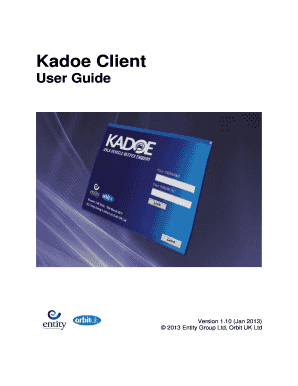
Get the free ics 207
Get, Create, Make and Sign ics org chart form



Editing ics 207 form online
How to fill out ics chart size blank form

How to fill out ICS 207:
Who needs ICS 207:
Unlocking the potential of ICS 207: A deep dive into integrated communication systems
Understanding ICS 207: An overview of its role in emergency management
ICS 207 is a crucial component of the Incident Command System (ICS), serving to organize and streamline communication during emergency management situations. Designed as a fillable form, ICS 207 provides vital information about organizational structure, key personnel, and the resources available during an incident. By clearly laying out this information, the form fosters effective communication, which is indispensable for coordinating successful incident responses.
The evolution of ICS forms, including ICS 207, reflects a growing recognition of the need for clarity in incident management. Initially developed in the 1970s, ICS forms were established to improve coordination amongst various response agencies. As emergency management practices evolved, so did the forms, expanding their adaptability to diverse situations. Today, ICS 207 stands as a testament to the importance of structured communication in successful incident management.
Core components of ICS 207: Breaking down the structure
ICS 207 consists of several key fields that provide comprehensive insight into the structure of an incident command. Identification of personnel is one of the first crucial components, which includes noting the Command Staff and General Staff. Clearly identifying these roles within the team facilitates communication and ensures that everyone understands where responsibilities lie. Functional assignments serve to highlight who is in charge of what, further aiding comprehensive crisis management.
Moreover, effective communication protocols detailed in ICS 207 are essential for operational efficiency. Including contact information for all key personnel ensures that everyone can connect quickly when rapid decisions are needed. The significance of structured communication protocols is amplified during emergencies where every second counts and knowing whom to reach is crucial. As a result, the form not only delineates roles but also provides a roadmap for engagement during incidents.
Navigating key terms and technical jargon in ICS 207
Understanding ICS 207 requires familiarity with certain key terms that enhance document integrity and efficiency. One such term is 'Xref/W,' which refers to cross-references used to enhance accuracy within the form. This feature ensures that all information is validated, minimizing errors that could compromise incident management. By utilizing cross-references, teams can create a more reliable dataset for decision-makers.
Another critical element is the need for generating unique IDs. These unique identifiers not only aid in tracking and accountability but also promote detailed documentation practices. When incidents escalate, being able to pinpoint resources and personnel through unique IDs can be critical for resource allocation and command clarity. Similarly, indexing for rapid information retrieval emphasizes the need for organizational structures within the document so that essential data can be quickly accessed during high-pressure scenarios.
Structural elements: From resource management to incident overview
Resource management is a pivotal structural element in ICS 207, serving as the backbone for effective incident response. Best practices for cataloging resources involve systematic documentation and comprehensive inventory management. Teams must assess available resources based on type, quantity, and capability, allowing for a more agile response during emergencies. This not only aids operational planning but also assures that resources can be efficiently allocated according to the needs of the incident.
The page layout and flow of ICS 207 also play a significant role. The standard organization of pages is designed for logical readability, ensuring that key pieces of information are easily accessible. Logical ordering allows responders to focus on critical aspects without wading through extraneous details. Moreover, the way pages flow into one another enhances usability, ensuring everyone involved can swiftly locate the information they need. Operational efficiency hinges on this structural clarity, which reinforces why ICS 207 is a fundamental tool in emergency management.
Document serialization: Utilizing streams and EOF
Incorporating document serialization is vital for maintaining clarity and coherence in ICS 207. Understanding the concept of streams is essential; these structured pathways allow for organized communication and fluid data processing. Well-defined streams ensure that information transitions smoothly from one piece of documentation to the next, which is critical during complex operations where quick access to prior information is necessary for making informed decisions.
End-of-file (EOF) markers are equally significant in the context of managing information lifecycles during incidents. EOF markers help demarcate the conclusion of data, ensuring stability and integrity in communication. They prevent data overflow and confusion during documentation processes, thereby contributing to reduced errors and miscommunications. By implementing effective serialization strategies, teams can enhance their operational efficiency and communication reliability.
The transformative impact of ICS 207 on incident command
The tangible benefits of implementing ICS 207 become evident through various case studies. For instance, during natural disasters, organizations utilizing ICS 207 have reported improved communication and coordination among different response teams. These instances showcase how a structured communication system fosters collaboration, ultimately enhancing the effectiveness of incident resolution. By examining these success stories, emergency response teams can extract invaluable lessons and best practices that inform future operations.
Lessons learned from real-world applications of ICS 207 highlight the significance of clarity in communication and the role of prepared documentation strategies. Practical insights derived from incidents demonstrate that organizations that embrace this structured approach can respond more efficiently, mitigate loss, and save lives. The transformative nature of ICS 207 underscores its position as an invaluable tool within the larger framework of incident management.
Future trends and innovations surrounding ICS 207
As technology continues to advance, the integration of artificial intelligence (AI) and machine learning into ICS forms is gaining traction. These technologies hold promise for improving data collection and analysis, thereby enhancing the effectiveness of ICS 207. For example, predictive analytics could anticipate resource needs based on past incidents, allowing command teams to prepare ahead of time and streamline the decision-making process.
Additionally, interoperability with other ICS forms is critical for achieving a cohesive incident management framework. Integrating ICS 207 with forms like ICS 201 and ICS 202 can facilitate seamless information transfer between teams, ensuring that all personnel are on the same page regarding incident status and resource allocation. This interconnectedness highlights the importance of a holistic approach in incident management while showcasing how ICS 207 can fit into broader communication strategies.
Achieving effective communication in crisis situations
Effective communication is paramount in crisis situations, and ICS 207 plays a vital role in facilitating that communication. By standardizing formats for information sharing, teams can minimize misunderstandings and streamline operations. Furthermore, incorporating feedback mechanisms into the ICS 207 workflow ensures that documentation continues to evolve in response to user experiences, enhancing its usability over time. Training and preparedness are also essential, equipping teams with the knowledge required to leverage ICS 207 during emergencies.
Preparedness training should focus on real-world scenario simulations, allowing teams to practice utilizing ICS 207 in various incident contexts. This hands-on approach builds familiarity and confidence, ensuring that all personnel understand their roles and responsibilities. Well-prepared teams can significantly improve response times and overall incident management efficiency, showcasing the transformative power of effective communication strategies.
Challenges and considerations in implementing ICS 207
Despite the advantages of ICS 207, several challenges can impede effective implementation. Common obstacles include personnel resistance to adopting new processes and insufficient training on the document's use. These hurdles can lead to fragmented communication and mismanaged resources during incidents. Addressing these challenges requires a proactive approach, focusing on building trust and rapport among teams.
Strategies to overcome these challenges involve demonstrating the tangible benefits of ICS 207 through simulations and training sessions. Engaging team members in discussions about the value of using a standardized approach can foster a sense of ownership. Furthermore, continuous education and practice can help alleviate apprehension around adopting new technologies, ultimately enhancing ICS 207's integration within organizations.
Empowering teams: The human element of ICS 207
While documents like ICS 207 provide essential structure, it is the human element that ultimately empowers effective incident management. Strengthening collaboration and cohesion within the Incident Command Structure fosters a greater sense of teamwork. Encouraging open dialogues between team members helps establish a supportive environment where everyone feels their input is valued.
Moreover, building a culture of preparedness through effective communication tools is key. Regular drills and training sessions can reinforce familiarity with ICS 207 and its role in incident management, contributing to improved response efficiency. By prioritizing both technology and human collaboration, organizations can better prepare their teams to handle incidents with confidence and competence.
Reflections on the essential role of ICS 207 in modern incident command systems
Reflecting on the pivotal role of ICS 207 emphasizes its transformative power in bolstering operational effectiveness. As a linchpin in incident command systems, this form streamlines communication, enhances resource management, and promotes accountability, which ultimately leads to more successful incident resolutions. The ongoing evolution of document management tools, as seen with ICS 207, underscores their importance in ensuring responsive and effective incident command.
In conclusion, embracing ICS 207 as part of a comprehensive incident management strategy can yield significant benefits. Organizations that integrate this form into their emergency response frameworks stand to gain enhanced communication, improved operational efficiencies, and stronger team dynamics, paving the way for more resilient, prepared teams ready to tackle complex incidents.
Video instructions and help with filling out and completing ics 207
Instructions and Help about ics org chart word
What you see here is the incident command systems basic organization it's made up of two distinct parts the upper part all in white is called the command staff the lower sections that are in the colors the red blue orange is yellow are and green is called the general staff the incident commander is the person who is in charge of the all overall incident the rest are his team to help him manage the incident the command staff reports directly to the incident commander or a deputy incident commander as shown here the Safety Officer is responsible for the overall safety of the incident public information officer is responsible for the development and release of incident information to the public sector through mass media of various forms the legal officer is legal counsel used as consultants per se for the response or any other legal issues that may arise and the liaison officer is a person who acts as a liaison between governmental organizations and non-governmental organizations that may have a stake in the incident but are not directly involved in the incident itself so in the general staff the Operations Section is responsible for conducting overall tactical operations of the incident planning section is responsible for developing both current and strategic and tactical plans for the incident the logistics section is responsible for all the supplies and services and support ordering a procurement and contracting for the incident and the finance section is basically the ones who pay everything that logistics orders that operations requests, so that's basically how this flow works, so this is the overall organizational chart this organization can shrink or expand according to the needs of the response not all sections or units or groups or branches have to be filled, or you can create your own so what we're going to show you next is an example of how an operation section the operations can expand even further so if you look over here to the red operations section down about three to the fourth group below the operations section you see source control branch and so now for the source control branch we can expand that even further so what you see here is an expansion of the source control branch so at the very top you'll see the source control branch director if you remember back on the ICS form itself correction on the ICS organization itself there was a source control branch that box is this box represented here as a source control branch director so under the source control branch director and source meaning is the source this particular one is the source of a well deepwater subsea well control issue and so this is a well source control branch you can see how the various groups under that organized and basically a lot of them kinds of mirror the organization above the general ICS organization, so they have a liaison a public information officer a safety of finance specialists logistics and planning specialists, and you can see it depicted in...
People Also Ask about ics organizational chart template
What is the purpose of the ICS 201 form?
What is the purpose of an ICS 211 form?
What is the purpose of the ICS 204?
Who fills out ICS Form 201?
Who fills out ICS forms?
How do I create an Incident Command Post?
Who is responsible for ICS?
Which incident type requires regional or national 200?
Our user reviews speak for themselves
For pdfFiller’s FAQs
Below is a list of the most common customer questions. If you can’t find an answer to your question, please don’t hesitate to reach out to us.
What is ics 207?
Who is required to file ics 207?
What information must be reported on ics 207?
How to fill out ics 207?
What is the purpose of ics 207?
How do I modify my ics form 207 in word in Gmail?
Where do I find ics template?
How do I fill out the ics form form on my smartphone?
pdfFiller is an end-to-end solution for managing, creating, and editing documents and forms in the cloud. Save time and hassle by preparing your tax forms online.




























